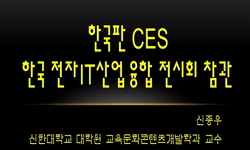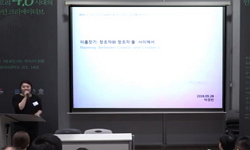현대 시장의 주요 특징 중 하나는 유사성과 동질성이 시장을 주도한다는 점이며, 이러한 특징은 전시산업에서도 나타나고 있다. 참관객이 인지하는 전시회의 브랜드네임은 현재 매우 유사...
http://chineseinput.net/에서 pinyin(병음)방식으로 중국어를 변환할 수 있습니다.
변환된 중국어를 복사하여 사용하시면 됩니다.
- 中文 을 입력하시려면 zhongwen을 입력하시고 space를누르시면됩니다.
- 北京 을 입력하시려면 beijing을 입력하시고 space를 누르시면 됩니다.
https://www.riss.kr/link?id=T14566964
- 저자
-
발행사항
서울 : 경희대학교 대학원, 2017
- 학위논문사항
-
발행연도
2017
-
작성언어
한국어
-
주제어
전시회 ; 참관객 ; 브랜드 네임 ; 브랜드 네임 스펙트럼 ; 고객기반 브랜드 자산
-
DDC
658.3 판사항(22)
-
발행국(도시)
서울
-
기타서명
The effects of a naming strategy through the brand name spectrum on the formation of customer-based brand equity at domestic trade fairs
-
형태사항
iv, 87 p. : 삽화 ; 26 cm
-
일반주기명
경희대학교 논문은 저작권에 의해 보호받습니다.
지도교수: 김봉석
참고문헌: p. 75-81 -
UCI식별코드
I804:11006-200000068856
- 소장기관
-
0
상세조회 -
0
다운로드
부가정보
국문 초록 (Abstract)
이에 본 연구의 목적은 브랜드의 구성요소로서의 ‘네임’이 전시회의 고객기반 브랜드 자산 형성에 영향을 미칠 수 있는가를 실증적으로 검증하여 학문적 시사점을 제공하고자 하는 것이며, 전시 산업에서의 네이밍 전략의 중요도를 고찰해보고, 체계적인 네이밍 전략을 위한 방향을 모색하여 실무적 시사점을 제공하고자 하는 것이다.
본 연구의 목적 달성을 위해서 탐색적 연구와 실증분석을 수행하였다. 브랜드 네임 스펙트럼의 개념을 도입하여 2015년 개최된 전시회 567개를 대상으로 전수조사를 실시하여 전시회 브랜드 네이밍 현황 분석을 실시하였다. 이후 실증분석을 위하여 전시회 브랜드 네임의 속성을 설명어군 네임, 연상어군 네임, 독립어군 네임으로 설정하고 각각의 속성에 해당하는 전시회명을 최종 선정하였다. 2017년 05월 10일부터 19일까지 전기/전자/정보통신/방송 분야의 전시회와 농수축산/식음료 분야의 전시회의 참관객을 대상으로 설문조사를 실시하여 총 612부의 유효 데이터를 수집하였다.
본 연구의 실증분석을 위하여 SPSS ver.23.0과 Smart PLS ver.2.0을 사용하였다. 탐색적 요인분석을 통하여 ‘설명어군 네임’, ‘연상어군 네임’, ‘독립어군 네임’, ‘브랜드 인지/연상’, ‘고객판단’, ‘고객감정’, ‘고객과 브랜드 간 공명성’의 7가지 요인이 도출되었다. 경로분석을 통하여 가설을 검증한 결과 연상어군 네임, 독립어군 네임은브랜드 인지/연상에 유의한 영향을 미치는 것으로 나타났으나, 설명어군 네임은 브랜드 인지/연상에 유의한 영향을 미치지 않는 것으로 나타났다. 또한, 브랜드 인지/연상에서 고객 브랜드 간 공명성과의 경로를 검증한 결과 브랜드 인지/연상은 고객판단과 고객감정을 거쳐 영향을 미치는 것으로 나타났으며, 브랜드 인지/연상이 직접적으로 고객 브랜드 간 공명성에 영향을 미치지는 않는다는 결과를 도출하였다.
본 연구는 국내 전시산업의 네이밍 현황을 브랜드 네임 스펙트럼의 개념을 통하여 고찰해보고, 전시회의 네임이 동인으로서 작용한 고객기반 브랜드 자산 형성 모형의 인과관계를 검증하였다는 점에서 학문적 시사점이 있다. 또한, 설명어군 네임이 주를 이루고 있는 현재의 전시 현황 가운데 참관객의 인지 및 연상을 강화시키고 나아가 고객과 브랜드 간의 관계를 구축하기 위한 효과적인 전략마련의 방향성을 제시하였다는 점에서 실무적 시사점이 있다.
현대 시장의 주요 특징 중 하나는 유사성과 동질성이 시장을 주도한다는 점이며, 이러한 특징은 전시산업에서도 나타나고 있다. 참관객이 인지하는 전시회의 브랜드네임은 현재 매우 유사한 방식으로 구성이 되어 있으며, 식별하는 것이 어려운 실정이다. 전시회명은 참관객들이 전시회를 떠올릴 때 가장 먼저 접하는 것으로 전시회가 하나의 브랜드로서 입지를 굳히기 위하여 중요하게 고려하여야 할 요소이다. 따라서 전시회를 기획하는 주최자들은 참관객들의 전시회 브랜드 네임에 대한 선호도를 파악함으로써 체계적인 네이밍 전략을 수립할 필요가 있다.
이에 본 연구의 목적은 브랜드의 구성요소로서의 ‘네임’이 전시회의 고객기반 브랜드 자산 형성에 영향을 미칠 수 있는가를 실증적으로 검증하여 학문적 시사점을 제공하고자 하는 것이며, 전시 산업에서의 네이밍 전략의 중요도를 고찰해보고, 체계적인 네이밍 전략을 위한 방향을 모색하여 실무적 시사점을 제공하고자 하는 것이다.
본 연구의 목적 달성을 위해서 탐색적 연구와 실증분석을 수행하였다. 브랜드 네임 스펙트럼의 개념을 도입하여 2015년 개최된 전시회 567개를 대상으로 전수조사를 실시하여 전시회 브랜드 네이밍 현황 분석을 실시하였다. 이후 실증분석을 위하여 전시회 브랜드 네임의 속성을 설명어군 네임, 연상어군 네임, 독립어군 네임으로 설정하고 각각의 속성에 해당하는 전시회명을 최종 선정하였다. 2017년 05월 10일부터 19일까지 전기/전자/정보통신/방송 분야의 전시회와 농수축산/식음료 분야의 전시회의 참관객을 대상으로 설문조사를 실시하여 총 612부의 유효 데이터를 수집하였다.
본 연구의 실증분석을 위하여 SPSS ver.23.0과 Smart PLS ver.2.0을 사용하였다. 탐색적 요인분석을 통하여 ‘설명어군 네임’, ‘연상어군 네임’, ‘독립어군 네임’, ‘브랜드 인지/연상’, ‘고객판단’, ‘고객감정’, ‘고객과 브랜드 간 공명성’의 7가지 요인이 도출되었다. 경로분석을 통하여 가설을 검증한 결과 연상어군 네임, 독립어군 네임은브랜드 인지/연상에 유의한 영향을 미치는 것으로 나타났으나, 설명어군 네임은 브랜드 인지/연상에 유의한 영향을 미치지 않는 것으로 나타났다. 또한, 브랜드 인지/연상에서 고객 브랜드 간 공명성과의 경로를 검증한 결과 브랜드 인지/연상은 고객판단과 고객감정을 거쳐 영향을 미치는 것으로 나타났으며, 브랜드 인지/연상이 직접적으로 고객 브랜드 간 공명성에 영향을 미치지는 않는다는 결과를 도출하였다.
본 연구는 국내 전시산업의 네이밍 현황을 브랜드 네임 스펙트럼의 개념을 통하여 고찰해보고, 전시회의 네임이 동인으로서 작용한 고객기반 브랜드 자산 형성 모형의 인과관계를 검증하였다는 점에서 학문적 시사점이 있다. 또한, 설명어군 네임이 주를 이루고 있는 현재의 전시 현황 가운데 참관객의 인지 및 연상을 강화시키고 나아가 고객과 브랜드 간의 관계를 구축하기 위한 효과적인 전략마련의 방향성을 제시하였다는 점에서 실무적 시사점이 있다.
다국어 초록 (Multilingual Abstract)
The aim of this paper is to empirically verify the effects of brand name on the formation of customer-based brand equity (CBBE) in domestic trade fairs and academically present the implications of the research findings. In addition, the purpose of this paper is to utilize these operational implications by devising strategic and effective brand-naming methods.
An exploratory study and empirical analyses were conducted. To determine the current naming conditions in the exhibition industry, complete enumeration was conducted on 567 exhibitions held in 2015. These were investigated by using the concept of ‘the brand name spectrum.’ Brand name attributes were divided into three categories: descriptive brand name, associative brand name, and freestanding brand name. To collect samples, the survey was carried out in convention and exhibition centers between May 10th and May 19th, during which time 612 valid samples were collected.
For empirical analyses, SPSS ver. 23.0 and Smart PLS ver. 2.0 were utilized. Through exploratory factor analysis, seven variable categories were discovered: descriptive brand name, associative brand name, freestanding brand name, exhibition brand awareness/association, customer judgment, customer feeling, and customer–brand resonance. The result of this paper was that associative brand names and freestanding brand names have a positive effect on exhibition brand awareness/association, and descriptive brand names do not have any effect on exhibition brand awareness/association. Furthermore, exhibition brand awareness/association has a positive effect on customer–brand resonance only if customer judgment and customer feeling act as a bridge between exhibition brand awareness/association and customer–brand resonance. Exhibition brand
awareness/association does not have a direct effect on customer-brand resonance.
This paper presents the academic implications of empirical verification concerning the effects of brand name on the formation of CBBE in domestic trade fairs. In addition, this paper presents the operational implications of the usage of strategic and effective brand naming methods in order to improve visitors’ awareness and associative ability.
The modern market is driven by similarity and homogeneity, and the two features also appear in the exhibition industry. Because the numerous brand names at exhibitions look very similar to one another, visitors have difficulty accurately distinguishin...
The modern market is driven by similarity and homogeneity, and the two features also appear in the exhibition industry. Because the numerous brand names at exhibitions look very similar to one another, visitors have difficulty accurately distinguishing and identifying certain brand names. Visitors tend to primarily recall the exhibition name when they think of certain exhibition brands. In other words, the brand name is one of the most important factors in the success of a brand. Thus, it is necessary for marketers to determine visitor preferences for brand names and establish strategies in order to attract more visitors.
The aim of this paper is to empirically verify the effects of brand name on the formation of customer-based brand equity (CBBE) in domestic trade fairs and academically present the implications of the research findings. In addition, the purpose of this paper is to utilize these operational implications by devising strategic and effective brand-naming methods.
An exploratory study and empirical analyses were conducted. To determine the current naming conditions in the exhibition industry, complete enumeration was conducted on 567 exhibitions held in 2015. These were investigated by using the concept of ‘the brand name spectrum.’ Brand name attributes were divided into three categories: descriptive brand name, associative brand name, and freestanding brand name. To collect samples, the survey was carried out in convention and exhibition centers between May 10th and May 19th, during which time 612 valid samples were collected.
For empirical analyses, SPSS ver. 23.0 and Smart PLS ver. 2.0 were utilized. Through exploratory factor analysis, seven variable categories were discovered: descriptive brand name, associative brand name, freestanding brand name, exhibition brand awareness/association, customer judgment, customer feeling, and customer–brand resonance. The result of this paper was that associative brand names and freestanding brand names have a positive effect on exhibition brand awareness/association, and descriptive brand names do not have any effect on exhibition brand awareness/association. Furthermore, exhibition brand awareness/association has a positive effect on customer–brand resonance only if customer judgment and customer feeling act as a bridge between exhibition brand awareness/association and customer–brand resonance. Exhibition brand
awareness/association does not have a direct effect on customer-brand resonance.
This paper presents the academic implications of empirical verification concerning the effects of brand name on the formation of CBBE in domestic trade fairs. In addition, this paper presents the operational implications of the usage of strategic and effective brand naming methods in order to improve visitors’ awareness and associative ability.
목차 (Table of Contents)
- 제 1 장 서 론 1
- 제 1 절 연구배경 및 문제제기 1
- 제 2 절 연구목적 5
- 제 3 절 연구방법 및 구성 6
- 제 2 장 이론적 배경 8
- 제 1 장 서 론 1
- 제 1 절 연구배경 및 문제제기 1
- 제 2 절 연구목적 5
- 제 3 절 연구방법 및 구성 6
- 제 2 장 이론적 배경 8
- 제 1 절 전시회의 개념 및 분류 체계 8
- 1. 전시회의 개념 8
- 2. 전시회의 분류 체계 9
- 제 2 절 브랜드와 브랜드 네임 스펙트럼 12
- 1. 브랜드 및 브랜드 네임의 개념 12
- 2. 브랜드 네임 스펙트럼 14
- 제 3 절 고객기반 브랜드 자산의 개념 및 구성요소 26
- 1. 고객기반 브랜드 자산의 개념 26
- 2. 고객기반 브랜드 자산의 구성요소 30
- 3. 브랜드 네임과 고객기반 브랜드 자산의 관계 32
- 제 3 장 연구방법 35
- 제 1절 연구모형 및 가설설정 35
- 제 2 절 조작적 정의 41
- 제 3 절 측정항목 개발 및 설문지 구성 44
- 제 4 절 조사설계 및 분석방법 47
- 제 4 장 실증분석 50
- 제 1 절 표본의 특성 50
- 제 2 절 신뢰성 및 타당성 분석 52
- 제 3 절 측정모형의 검증 59
- 제 4 절 가설의 검증 64
- 제 5 장 결 론 67
- 제 1 절 연구의 요약 67
- 제 2 절 연구의 시사점 70
- 제 3 절 연구의 한계점 및 향후 연구 과제 74
- Ⅰ. 참 고 문 헌 75
- Ⅱ. 설 문 지 81
- Ⅲ. Abstract 86










